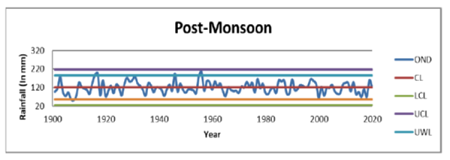


Indian Journal of Science and Technology
Year: 2022, Volume: 15, Issue: 8, Pages: 351-356
Original Article
Kandukuri Kumaraswamy1*
1Statistical Officer, KNRUHS, Telangana, Warangal, India
*Corresponding Author
Email: [email protected]
Received Date:01 November 2021, Accepted Date:19 January 2022, Published Date:02 March 2022
Objectives: To identify the trend and variability of precipitation in the Indian subcontinent. Methods: To identify the trend component the non-parametric test statistic Mann - Kendall and Statistical Process Control (SPC) methodologies are used to conduct a statistical study. Findings: Precipitation of India has shown decreasing trend throughout the winter, monsoon, and on an annual basis, and an increasing tendency was observed during the rest of the seasons. During the winter season, there was more variation in precipitation with Coefficient of Variance (CV) is 33.7919%. Novelty: The long period (120 years) average data from 1901 - 2020 is used to know the long run trend and distribution pattern variation of precipitation in India with the proposed statistical methods. Applications: This mechanism is suitable to change the crop pattern and manage the adverse effects in associated sectors.
Keywords: Statistical Process Control; India; Mann Kendall Statistic; Precipitation; Trend
© 2022 Kumaraswamy. This is an open-access article distributed under the terms of the Creative Commons Attribution License, which permits unrestricted use, distribution, and reproduction in any medium, provided the original author and source are credited.
Published By Indian Society for Education and Environment (iSee)
Subscribe now for latest articles and news.